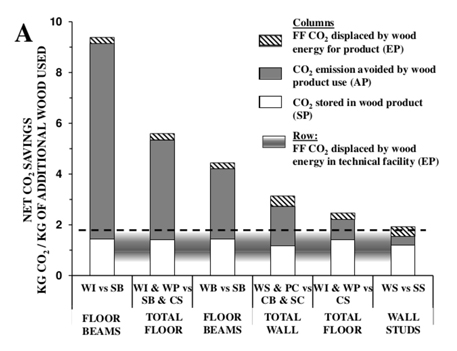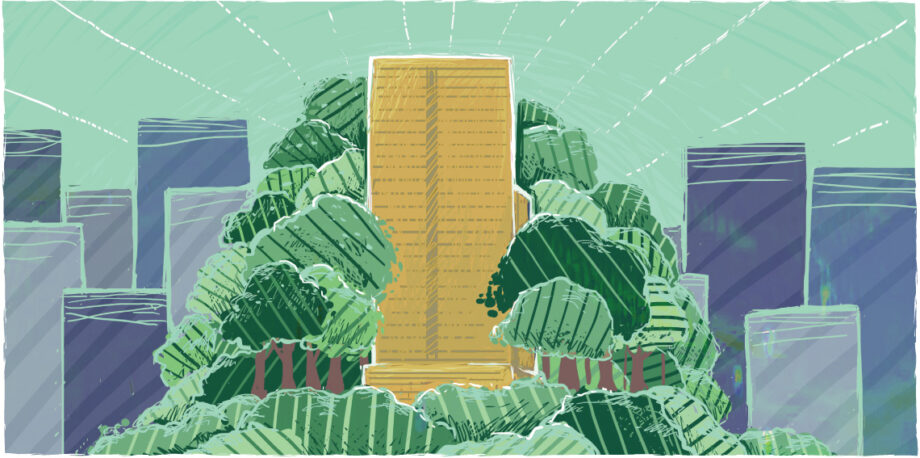August 5, 2014 — Although it may seem counterintuitive, it would be better if we built buildings from wood than from concrete, brick, aluminium and steel.
We use millions of tons of these modern materials every year. They have many valuable properties, but are energy-intensive to create, accounting for around 16 percent of the entire planets’ fossil fuel production. Instead we could be using wood, which is also strong, renewable and plentiful — we use only a fraction of the world’s available forestry resources.
Our research, published in the Journal of Sustainable Forestry, estimated that the world’s forest contain about 385 billion cubic meters of wood, with an additional 17 billion cubic meters growing each year. A mere 3.4 billion cubic meters is harvested each year, mostly for subsistence fuel burning; the rest rots, burns in fires or adds to forests’ density.
Swapping steel, concrete or brick for wood and specially engineered wood equivalents would drastically reduce global carbon dioxide emissions and fossil fuel consumption and would represent a renewable resource. What’s more, managed properly this can be done without loss of biodiversity or carbon storage capacity.
Wooden Approach
In our study undertaken by scientists from the Yale School of Forestry & Environmental Studies and the University of Washington’s College of the Environment, we evaluated various scenarios including leaving forests untouched, burning wood for energy and use of wood as a construction material.
The 3.4 billion cubic meters of wood harvested each year accounts for only 20 percent of new annual growth. Increasing the wood harvest to 34 percent or more would have several profound and positive effects. Emissions amounting to 14 to 31 percent of global CO2 would be avoided by creating less steel and concrete, and by storing CO2 in the cell structure of wood products. A further 12 to 19 percent of annual global fossil fuel consumption would be saved, including savings from burning scrap wood and unsellable materials for energy.

CO2 savings from using engineered wood I-beams, wood beams, wood ply, wood sheathing, ply covering and wood studs vs. equivalent steel beams, concrete slabs, steel studs and stucco. Image by Chad Oliver et. al/JSF.
Building with wood consumes much less energy than using concrete or steel. For example, a wooden floor beam requires 80 megajoules of energy per square meter of floor space and emits 4 kg CO2. By comparison, a square meter of floor space supported by a steel beam requires 516 mj and emits 40 kg of CO2, and a concrete slab floor requires 290 mj and emits 27 kg of CO2.
By using efficient harvesting and production techniques, more CO2 is saved through the avoided emissions, materials and wood energy than is lost from the harvested forest — yet another reason to appreciate forests and to protect them from endless deforestation for agriculture. Clearing trees for harvest is temporary, but converting forests to farmland is a permanent loss of all forest’s resources and biodiversity.
Wooden Materials

Stadthaus, a residential building in Hackney, London, was built using cross-laminated timber panels. Photo by hoxtonchina (Flickr/Creative Commons).
If transport and assembly is taken into account, the 16 percent of global fossil fuels used to manufacture steel, concrete and brick is closer to 20 to 30 percent. These potential fuel and carbon emissions savings, already substantial, will become increasingly critical as demand for new buildings, bridges and other infrastructure surges with economic development in Asia, Africa and South America. At the same time, new construction techniques have made wood even more effective as a building material for anything from bridges to mid-rise apartment buildings. The cross-laminated timber increasingly used in new buildings, made from alternating layers of perpendicular wood pieces, has strength approaching that of steel.
In 2009 a nine-story building, Stadthaus, in London, was built with CLT instead of steel construction, and in Stockholm a 34-story wooden building has been given planning permission. There are many others, already built and in the pipeline.
Harvesting also reduces a forest’s likelihood of suffering a catastrophic wildfire, and improves its ability to withstand it. Maintaining a mix of forest habitats and tree densities in nonreserved forests would help preserve the varied biodiversity in ecosystems worldwide. Harvesting wood will save fossil fuel and CO2, and provide jobs — giving local people more reason to ensure the forests’ survival. ![]()
![]()
Editor’s note: The views expressed here are those of the author and not necessarily of Ensia. We present them to further discussion around important topics. We encourage you to respond with a comment below, following our commenting guidelines, which can be found here. In addition, you might consider submitting a Voices piece of your own. See Ensia’s “Contact” page for submission guidelines.
This article was originally published on The Conversation. Read the original article.
Disclosure statement: Chad Oliver has minor ownership (5 percent) in a forest inventory company, SilviaTerra. In the past, he has consulted for the forest industry, the U.S. Forest Service, the United Nations, and other public and private organizations in his scientific capacity as an academician.
Ensia shares solutions-focused stories free of charge through our online magazine and partner media. That means audiences around the world have ready access to stories that can — and do — help them shape a better future. If you value our work, please show your support today.
Yes, I'll support Ensia!

First, as noted above, forests serve many purposes beyond simply providing building materials to humans. Biodiversity, drinking water, clean air, cultural values and more depend on forests. Trees left standing do not simply rot, as the author claims.
Next, harvest happens in specific places. Even a small increase in global harvest levels won't be spread across the world. Rather, some regions will bear the brunt and others won't.
The real question: How is the forest being managed?
A well managed forest can provide a sustainable supply of building materials. A poorly managed forest supplies materials that can be demonstrably worse than recycled steel or concrete.
The forest products industry is pushing hard for wood to replace steel and concrete, just as they are pushing hard for forest biomass to be used as a "renewable" source of energy.
The reality is somewhat more nuanced. Forest management matters, and not all forests are managed well. In fact, forest degradation - often driven by demands for building materials and fuel - is a leading cause of carbon pollution.
We probably should build more with wood. But let's not miss the forest for the trees.